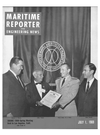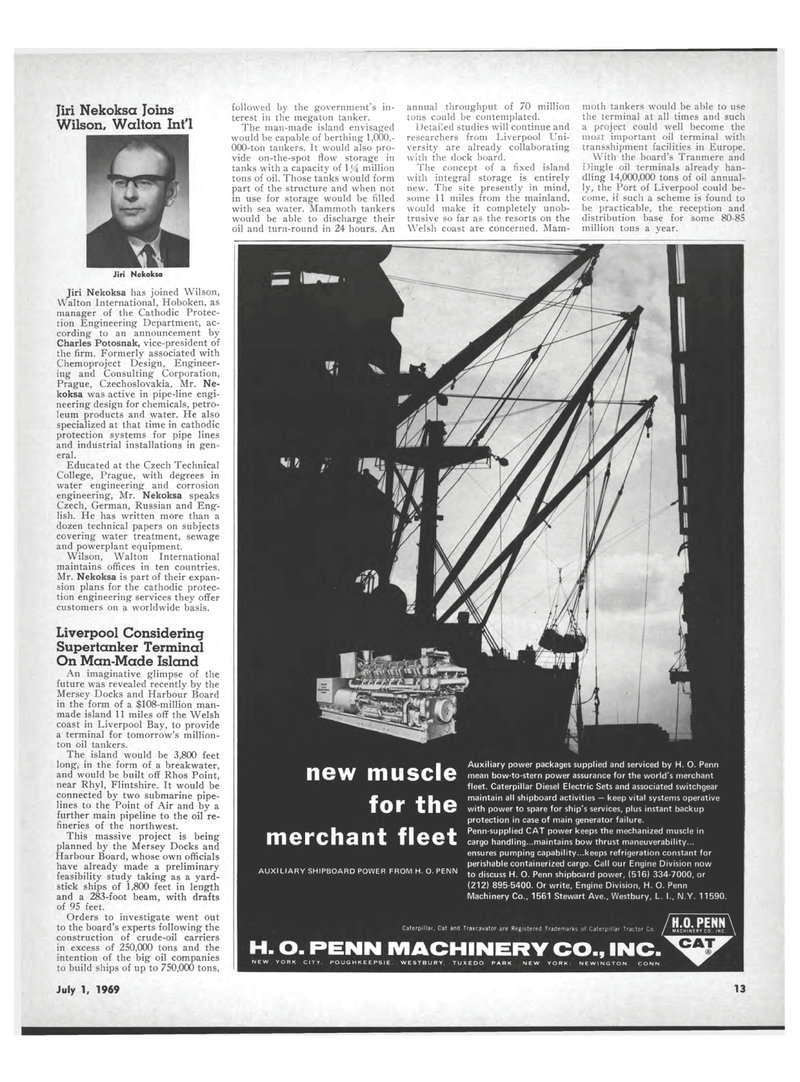
Page 11: of Maritime Reporter Magazine (July 1969)
Read this page in Pdf, Flash or Html5 edition of July 1969 Maritime Reporter Magazine
Jiri Nekoksa Joins Wilson, Walton Int'l Jiri Nekoksa Jiri Nekoksa has joined Wilson, Walton International, Hoboken, as manager of the Cathodic Protec-tion Engineering Department, ac-cording to an announcement by Charles Potosnak, vice-president of the firm. Formerly associated with Chemoproject Design, Engineer-ing and Consulting Corporation, Prague, Czechoslovakia, Mr. Ne-koksa was active in pipe-line engi-neering design for chemicals, petro-leum products and water. He also specialized at that time in cathodic protection systems for pipe lines and industrial installations in gen-eral. Educated at the Czech Technical College, Prague, with degrees in water engineering and corrosion engineering, Mr. Nekoksa speaks Czech, German, Russian and Eng-lish. He has written more than a dozen technical papers on subjects covering water treatment, sewage and powerplant equipment. Wilson, Walton International maintains offices in ten countries. Mr. Nekoksa is part of their expan-sion plans for the cathodic protec-tion engineering services they offer customers on a worldwide basis. Liverpool Considering Supertanker Terminal On Man-Made Island An imaginative glimpse of the future was revealed recently by the Mersey Docks and Harbour Board in the form of a $108-million man-made island 11 miles off the Welsh coast in Liverpool Bay, to provide a terminal for tomorrow's million-ton oil tankers. The island would be 3,800 feet long, in the form of a breakwater, and would be built off Rhos Point, near Rhyl, Flintshire. It would be connected by two submarine pipe-lines to the Point of Air and by a further main pipeline to the oil re-fineries of the northwest. This massive project is being planned by the Mersey Docks and Harbour Board, whose own officials have already made a preliminary feasibility study taking as a yard-stick ships of 1,800 feet in length and a 283-foot beam, with drafts of 95 feet. Orders to investigate went out to the board's experts following the construction of crude-oil carriers in excess of 250,000 tons and the intention of the big oil companies to build ships of up to 750,000 tons, followed by the government's in-terest in the megaton tanker. The man-made island envisaged would be capable of berthing 1,000,-000-ton tankers. It would also pro-vide on-the-spot flow storage in tanks with a capacity of million tons of oil. Those tanks would form part of the structure and when not in use for storage would be filled with sea water. Mammoth tankers would be able to discharge their oil and turn-round in 24 hours. An annual throughput of 70 million tons could be contemplated. Detailed studies will continue and researchers from Liverpool Uni-versity are already collaborating with the dock board. The concept of a fixed island with integral storage is entirely new. The site presently in mind, some 11 miles from the mainland, would make it completely unob-trusive so far as the resorts on the Welsh coast are concerned. Mam-moth tankers would be able to use the terminal at all times and such a project could well become the most important oil terminal with transshipment facilities in Europe. With the board's Tranmere and Dingle oil terminals already han-dling 14,000,000 tons of oil annual-ly, the Port of Liverpool could be-come, if such a scheme is found to be practicable, the reception and distribution base for some 80-85 million tons a year. July 1, 1969 11

 10
10

 12
12
